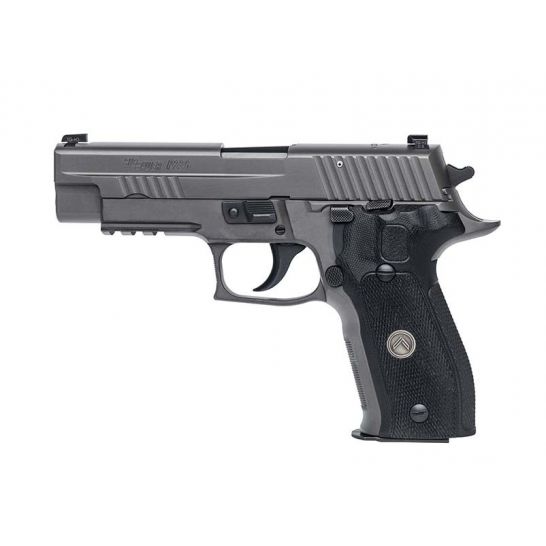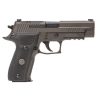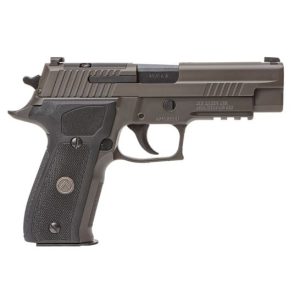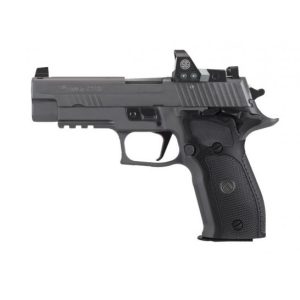Sig Sauer 9mm P226 Legion Pistol – E26R-9-Legion For Sale
$1,099.99
The Sig Sauer 9mm P226 Legion Pistol (model E26R-9-Legion) is a high-end firearm designed for functionality and aesthetics, featuring a custom PVD finish for enhanced durability and performance. It includes a Grayguns trigger for improved control, and X-RAY high visibility day/night sights with tritium elements for optimal visibility. The pistol’s rackable rear ledge allows for single-handed slide manipulation, making it a practical and attractive choice for both professionals and enthusiasts.
What is the difference between a P226 and a P226 Legion?
The main difference between a SIG Sauer P226 and a P226 Legion lies in their features, styling, and enhancements.
1. **Finish and Aesthetics**: The P226 Legion has a Cerakote Elite Legion Gray finish, giving it a distinctive appearance compared to the standard P226’s finish.
2. **Grips**: The Legion typically features custom G10 grips with the Legion logo, offering better ergonomics and grip compared to the standard grips on a regular P226.
3. **Sights**: The Legion series often comes with X-RAY3 Day/Night Sights, which provide enhanced visibility in low-light conditions, whereas the standard P226 may have less advanced night sights, or come with more basic sights depending on the model.
4. **Trigger**: The P226 Legion often includes a custom-tuned trigger with a short reset and reduces trigger pull weight, offering enhanced accuracy and shooting feel.
5. **Controls**: Legion models might have upgraded controls such as a low-profile decocking lever, slide catch lever, and takedown lever, designed to reduce snagging and improve handling.
6. **Frame**: The Legion series may feature the SIG Sauer’s Master Shop Near-Lock (MSP) frame, which offers a more precise fit and finish.
7. **Extras**: The P226 Legion often includes membership to the Legion Series community, offering access to exclusive products and events.
These enhancements make the P226 Legion a premium version of the standard P226, designed for users who desire additional features and performance upgrades.
Why did the Navy SEALs stop using the P226?
The Navy SEALs began transitioning from the SIG Sauer P226 to the Glock 19 as their primary sidearm in the mid-2010s. The decision to switch was influenced by a variety of factors:
1. **Size and Weight**: The Glock 19 is generally lighter and more compact than the P226, making it easier for operatives to carry during missions.
2. **Durability and Reliability**: The Glock has a reputation for being extremely durable and reliable in various conditions, which is crucial for the diverse environments Navy SEALs operate in.
3. **Magazine Capacity**: Glock pistols often have larger magazine capacities compared to the P226, allowing for more rounds to be carried without changing magazines.
4. **Standardization**: Transitioning to the Glock 19 also allowed for more standardization across different military units, which commonly use Glock models. This simplifies logistics and training.
5. **Maintenance**: Glocks are often considered easier and less expensive to maintain, which can be a practical consideration for military use.
Overall, the decision was based on the need for a modern, versatile, and reliable firearm that meets the evolving requirements of Navy SEAL operations.
Why is the Sig Legion so expensive?
The Sig Legion line is considered expensive primarily due to its high-quality construction, premium materials, advanced features, and performance enhancements. These firearms are typically designed with specific improvements such as superior ergonomics, enhanced triggers, and custom finishes that appeal to enthusiasts and professionals. Additionally, limited production runs and brand reputation contribute to their higher price point, as they are marketed as elite models within Sig Sauer’s product lineup.
What makes Sig Legion so special?
The Sig Sauer P320 Legion, often referred to simply as the Sig Legion, is considered special for several reasons:
1. **Enhanced Features**: The Sig Legion series generally includes a number of enhanced features over standard models. For the P320 Legion, this might include a skeletonized trigger, improved sights, and a better grip texture for enhanced handling and accuracy.
2. **Material and Finish**: Legion models often feature premium materials and finishes. The P320 Legion, for instance, usually comes with a Legion Gray PVD finish which adds durability and a distinct appearance.
3. **Customizability**: Sig Legion pistols often have increased modularity and customization options, allowing users to tailor the firearm to their specific needs. This might include modular trigger groups, changeable grips, and more.
4. **Performance Improvements**: The Legion series often focuses on performance improvements, such as lighter slide weight and recoil mitigating features, which can contribute to better shooting ergonomics and control.
5. **Custom Legion Add-ons**: Owners of a Sig Legion typically gain access to the Legion Series membership, offering exclusive products, merchandise, and opportunities.
6. **Tactical Advantage**: Designed with input from professional shooters and tactical experts, the Legion series often has features that make it appealing for both competitive shooting and tactical applications.
These factors contribute to why the Sig Legion series is highly regarded among firearms enthusiasts and professionals.
Is Sig P226 better than Glock?
Determining whether the Sig P226 is better than a Glock involves subjective evaluation and depends on what specific attributes you’re considering. Here are some points to consider:
1. **Reliability**: Both the Sig P226 and Glock handguns have strong reputations for reliability. Glocks are particularly known for their simplicity and durability.
2. **Trigger**: The Sig P226 typically features a double-action/single-action (DA/SA) trigger system, which some shooters prefer for its versatility. Glocks have a consistent, striker-fired trigger pull, which others may favor for simplicity.
3. **Ergonomics**: The Sig P226 generally has a heavier, metal frame, which some shooters find provides a better grip and handling. Glocks, with their polymer frames, tend to be lighter and may fit differently in the hand.
4. **Customization**: Glocks are known for a wide range of aftermarket parts and accessories, making them highly customizable.
5. **Price**: Generally, Glocks tend to be more affordable compared to the Sig P226, which is often priced higher due to its all-metal construction and manufacturing origin.
Ultimately, determining the better handgun depends on individual needs and preferences, such as intended use (e.g., self-defense, law enforcement, competition), comfort, and budget. It is best to try both firearms and consider these factors to make a well-informed decision.
Is SIG SAUER discontinuing the P226?
As of the latest available information, SIG SAUER has not officially announced the discontinuation of the P226. It’s always a good idea to check directly with SIG SAUER or their official announcements for the most up-to-date information regarding their product lineup.
Do SEALs prefer Glock or SIG?
U.S. Navy SEALs have historically used both Glock and SIG Sauer pistols, but they have shown a preference for the SIG Sauer P226 for many years. However, more recently, Glocks have also been adopted, with models like the Glock 19 being part of their arsenal. The choice between Glock and SIG Sauer can depend on specific mission requirements and personal preferences of the operators.
What is the life expectancy of a Sig P226?
The life expectancy of a Sig P226, like many high-quality firearms, largely depends on maintenance, usage, and environmental conditions. With proper care, regular maintenance, and use of quality ammunition, a Sig P226 can last for many tens of thousands of rounds. It is not uncommon for these firearms to remain functional and reliable after shooting over 50,000 rounds. However, individual experiences can vary, and proper handling and care are crucial for maximizing its lifespan.
Are SEALs tougher than Marines?
The toughness of Navy SEALs compared to Marines isn’t easily measurable, as both groups undergo rigorous training for different types of missions. Navy SEALs are an elite special operations force specializing in unconventional warfare, reconnaissance, and direct action missions, undergoing intense physical and mental training. Marines are also highly trained, versatile forces known for quick deployment and amphibious operations. The “toughness” depends on the mission requirements and skill sets rather than a direct comparison.
Where is the SIG P226 Legion made?
The SIG P226 Legion is made by SIG Sauer, and it is manufactured in Newington, New Hampshire, USA.
Does the SIG Legion have a safety?
Yes, the SIG Legion series, like the SIG P226 Legion and the P229 Legion, generally comes with a decocker but does not have a manual safety. However, features can vary slightly depending on the specific model and version, so it’s always good to verify with the manufacturer’s specifications or the specific model in question.
How many Sig Sauer Legion models are there?
As of the latest information available, Sig Sauer offers several models within their Legion Series. The Legion lineup includes variations of popular Sig Sauer handguns, such as the P226, P229, P220, P320, and others. Each of these models may have several configurations or iterations. However, the exact number of Legion models can change over time due to new releases or discontinuations. I recommend checking Sig Sauer’s official website or contacting a retailer for the most current list of available Legion models.
Which P226 do Navy SEALs use?
Navy SEALs have historically used the SIG Sauer P226, specifically the P226 MK25 variant. The MK25 is the standard Navy version of the P226, which includes features like a corrosion-resistant coating and an anchor engraving to denote its status as a military-issued firearm.
Does the SIG P226 Legion have a safety?
The SIG P226 Legion does not have an external manual safety lever, which is typical for many SIG Sauer pistols. Instead, it uses other safety mechanisms such as a decocker, a firing pin block, and an automatic safety if it is equipped with these features.
Which is better P226 or P229?
The comparison between the SIG Sauer P226 and P229 depends on the context and the specific needs or preferences of the user. Both are highly regarded in the firearm community, but here are some points to consider:
1. **Size and Weight**:
– **P226**: It’s larger with a longer barrel, which can translate to better accuracy and less perceived recoil. It’s often considered more suitable for duty use or home defense.
– **P229**: More compact and slightly lighter, making it a better choice for concealed carry or for those who prefer a smaller grip.
2. **Capacity**:
– Both models typically offer similar capacities, but the exact number of rounds can vary with the caliber and specific magazines used.
3. **Ergonomics**:
– Both have similar ergonomics typical of SIG Sauer pistols, but some may prefer the P229 for its slightly smaller grip circumference if they have smaller hands.
4. **Caliber Options**:
– Both are available in several calibers including 9mm, .40 S&W, and .357 SIG, allowing users to choose based on their preference and needs.
5. **Use Case**:
– **P226**: Generally favored by military and law enforcement for its accuracy and reliability in a larger package.
– **P229**: Often chosen by those who need something more compact without sacrificing too much performance.
Ultimately, the “better” option is subjective and reliant on the intended use, personal preference, and the shooter’s comfort with the firearm. It might be beneficial to handle or shoot both models if possible, to make an informed decision based on personal experience.
| Frame Size | Full-Size |
|---|---|
| Frame Finish | PVD |
| Frame Material | Alloy |
| Slide Finish | PVD |
| Slide Material | Stainless Steel |
| Grips | Black G10 |
| Sights | X-Ray (Square) |
| Sight Radius | 6.3" |
| Overall Length | 8" |
| Overall Width | 1.5"- 1.7" |
Be the first to review “Sig Sauer 9mm P226 Legion Pistol – E26R-9-Legion” Cancel reply
Related products
Sig Sauer P226 Legion
Sig Sauer P226 Legion 9mm Pistol 4.4" 10rd – 226R-9-LEGION-SAO-R2
Sig Sauer P226 Legion
Sig Sauer P226 Legion 9mm Pistol, SAO w/ Romeo 1- E26R-9-LEGION-SAO-RX




Reviews
There are no reviews yet.